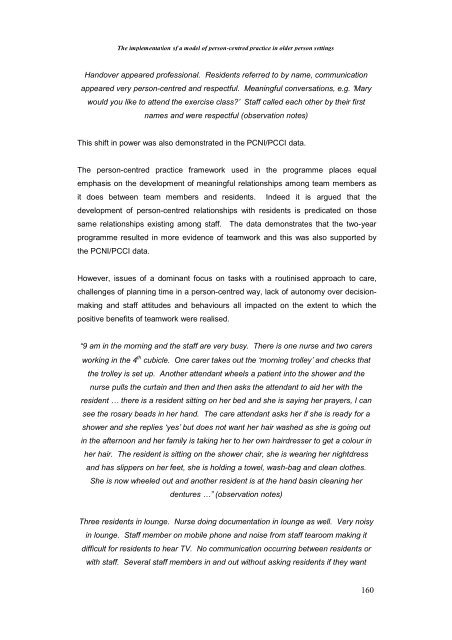The Implementation of a Model of Person-Centred Practice In Older ...
The Implementation of a Model of Person-Centred Practice In Older ...
The Implementation of a Model of Person-Centred Practice In Older ...
You also want an ePaper? Increase the reach of your titles
YUMPU automatically turns print PDFs into web optimized ePapers that Google loves.
<strong>The</strong> implementation <strong>of</strong> a model <strong>of</strong> person-centred practice in older person settings<br />
Handover appeared pr<strong>of</strong>essional. Residents referred to by name, communication<br />
appeared very person-centred and respectful. Meaningful conversations, e.g. ‘Mary<br />
would you like to attend the exercise class?’ Staff called each other by their first<br />
names and were respectful (observation notes)<br />
This shift in power was also demonstrated in the PCNI/PCCI data.<br />
<strong>The</strong> person-centred practice framework used in the programme places equal<br />
emphasis on the development <strong>of</strong> meaningful relationships among team members as<br />
it does between team members and residents. <strong>In</strong>deed it is argued that the<br />
development <strong>of</strong> person-centred relationships with residents is predicated on those<br />
same relationships existing among staff. <strong>The</strong> data demonstrates that the two-year<br />
programme resulted in more evidence <strong>of</strong> teamwork and this was also supported by<br />
the PCNI/PCCI data.<br />
However, issues <strong>of</strong> a dominant focus on tasks with a routinised approach to care,<br />
challenges <strong>of</strong> planning time in a person-centred way, lack <strong>of</strong> autonomy over decisionmaking<br />
and staff attitudes and behaviours all impacted on the extent to which the<br />
positive benefits <strong>of</strong> teamwork were realised.<br />
“9 am in the morning and the staff are very busy. <strong>The</strong>re is one nurse and two carers<br />
working in the 4 th cubicle. One carer takes out the ‘morning trolley’ and checks that<br />
the trolley is set up. Another attendant wheels a patient into the shower and the<br />
nurse pulls the curtain and then and then asks the attendant to aid her with the<br />
resident … there is a resident sitting on her bed and she is saying her prayers, I can<br />
see the rosary beads in her hand. <strong>The</strong> care attendant asks her if she is ready for a<br />
shower and she replies ‘yes’ but does not want her hair washed as she is going out<br />
in the afternoon and her family is taking her to her own hairdresser to get a colour in<br />
her hair. <strong>The</strong> resident is sitting on the shower chair, she is wearing her nightdress<br />
and has slippers on her feet, she is holding a towel, wash-bag and clean clothes.<br />
She is now wheeled out and another resident is at the hand basin cleaning her<br />
dentures …” (observation notes)<br />
Three residents in lounge. Nurse doing documentation in lounge as well. Very noisy<br />
in lounge. Staff member on mobile phone and noise from staff tearoom making it<br />
difficult for residents to hear TV. No communication occurring between residents or<br />
with staff. Several staff members in and out without asking residents if they want<br />
160
















